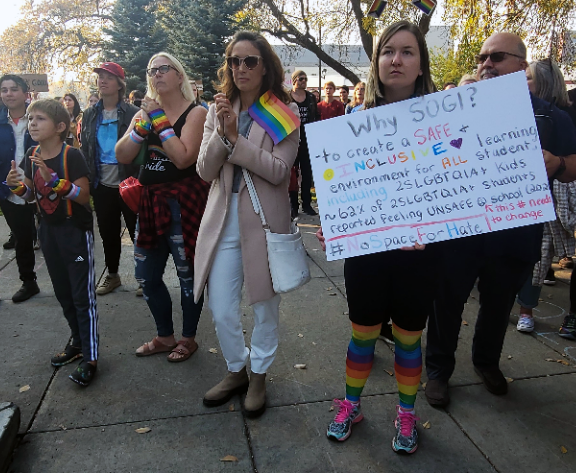Both sides of the SOGI debate say they want the same thing – to protect children.
Hearing virtually the same words come from speakers in opposing camps within moments of each other during pro- and anti-SOGI rallies across B.C. and Canada Wednesday put a somewhat a ironic twist on what was a tense but peaceful day, loaded with emotion for protesters on both sides.
SOGI stands for sexual orientation and gender identity education.
On one side, critics say children must be protected from it, while supporters say SOGI itself is the protection trans and non-binary youth need to feel safe at school.
So, what exactly is SOGI and what do our children learn from it?
"It isn't about being gay or trans, it's about keeping our kids safe," one woman said Wednesday.
Another said: "This has nothing to do with sexuality of adults, it's about keeping our kids safe."
Can you tell the difference?
"Teachers and schools choosing to address SOGI in the curriculum is not about students developing a particular set of beliefs around sexual orientation and gender identity. It is about building understanding of the diverse society that we live in and learning to treat each other with dignity and respect," Grade 6-7 teacher and SOGI lead Robyn Ladner said in an email.
Provincial statistics show 19% of B.C. high school students identify as gay, lesbian, bisexual or not exclusively heterosexual.
Among high school students, 1% identify as transgender and 5% of Aboriginal students identify as two-spirit.
Among all LGBTQ2IA+ students, a whopping 42% report being victims of cyberbullying, and lesbian, gay and bisexual youth are seven times more likely to attempt suicide.
These are the reasons SOGI exists.
Removal of it would lead to lives lost, Canadian Mental Health Vernon said.
SOGI is for all students, "as every person has a sexual orientation and every person has a gender identity," provincial documents on the program state.
The Ministry of Education SOGI policy guide says its three goals are visibility, protection, and inclusion.
SOGI 1 2 3 resources include grade-level appropriate lesson plans, online learning modules and customizable templates and tools that are interwoven through several curriculum areas, most notably, physical and health education, language arts, and social studies.
"How the topics are introduced to students is dependent on the age and stage of their development," the ministry says. "These topics may also be discussed as they arise in the daily lives of students."
Students may guide the conversation as much as the teacher. Topics include:
K-12 - Why "That's So Gay" is not OK Elementary
K/1 Social Studies & Physical and Health Education (PHE) – Family Diversity
K/1 Social Studies & PHE – Name Calling
2/3 English Language Arts & PHE – Gender Identity
2/3/4/5 English Language Arts & PHE– Questioning Gender Expectations
4/5 Physical and Health Education – Gender Identity, Media and Stereotypes
5/6 Social Studies - LGBTQ Human Rights
5/6/7 Arts Education & PHE – Gender Stereotypes and Bullying
6/7 PHE & English Language Arts – Gender and Appearance in Media
8/9 Physical and Health Education – Gender Identity
8/9 English Language Arts – Gender Stereotypes in Literature
8/9/10 English Language Arts – Social Justice Vocabulary
8/9/10/11/12 English Language Arts – Gender in Short Stories and Poetry
8/9/10 Physical and Health Education & 10/11/12 Social Studies – Language and Terminology
10/11/12 Social Studies / BC First Peoples / Indigenous Studies – Indigenous Perspectives of Gender
"When discussing gender, the conversations are largely about what people like to wear, the activities they engage in and how they feel about themselves. Gender is about self-identity. When students learn they are not bound by gender stereotypes, they have an opportunity to explore a greater range of interests, ideas and activities," the guidelines state.
"The ways that teachers may address SOGI in the curriculum are not about students developing a particular set of beliefs around sexual orientation and gender identity. Educators help students deepen the understanding of the diverse society that we live in and how to treat each other with dignity and respect regardless of our differences."
The program is supported by the BC Confederation of Parent Advisory Councils, and studies have shown it to reduce discrimination, suicidal ideation and suicide attempts for all students.



